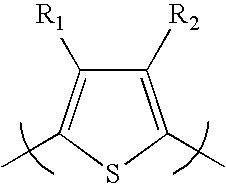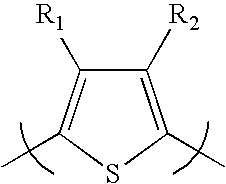Process for substituted polythiophene polymers
a polythiophene polymer and polymer technology, applied in the field of process for making substituted polythiophene polymers, can solve the problems of affecting the use of these polymers for such applications, affecting the quality of polymerization,
- Summary
- Abstract
- Description
- Claims
- Application Information
AI Technical Summary
Benefits of technology
Problems solved by technology
Method used
Image
Examples
example 1
Preparation of Regioregular HT Poly(3-hexylthiophene) from 2,5-Dibromo-3-hexylthiophene and Alkyl Grignard in the Presence of Zinc Chloride
[0070]In a 250 mL of round-bottom-flask, 2,5-dibromo-3-hexylthiophene (8.15 g, 25 mmol) was placed and 50 mL of THF was added. Then, the reaction flask was cooled down in an ice-bath. With being stirred at 0° C., cyclohexylmagnesium chloride (2.0M in ether, 12.5 mL, 25 mmol) was slowly added. After being stirred at 0° C. for 10 minutes, zinc chloride (0.5M in THF, 50 mL, 25 mmol) was added into the reaction mixture and allowed to warm up room temperature over 20 minutes. The resulting clear solution was added via a cannula into the flask containing Ni(dppe)Cl2 (0.08 g, 0.6 mol %) at room temperature. The mixture was stirred for 24 hours at room temperature. A dark-purple precipitate was formed gradually in this period. The mixture was poured into a solution of MeOH (100 mL) and 3 N HCl (10 mL). The resulting dark precipitate was filtered and wash...
example 2
Exemplary poly(3-substituted-thiophenes)
[0072]Scheme 1 illustrates several of the polythiophenes that can be prepared by the methods described herein, wherein n is a value such that the polythiophene polymer as a molecular weight of about 10,000 to about 200,000; “Hex” is hexyl but can be any alkyl group as described herein; “Bn” is benzyl which can be optionally substituted as described herein; “Ar” is aryl as described herein; “Het” is heteroaryl or heterocycle as described herein; m is 1 to about 20; and R is alkyl as described herein.
PUM
| Property | Measurement | Unit |
|---|---|---|
| temperature | aaaaa | aaaaa |
| temperature | aaaaa | aaaaa |
| temperature | aaaaa | aaaaa |
Abstract
Description
Claims
Application Information
 Login to View More
Login to View More - R&D
- Intellectual Property
- Life Sciences
- Materials
- Tech Scout
- Unparalleled Data Quality
- Higher Quality Content
- 60% Fewer Hallucinations
Browse by: Latest US Patents, China's latest patents, Technical Efficacy Thesaurus, Application Domain, Technology Topic, Popular Technical Reports.
© 2025 PatSnap. All rights reserved.Legal|Privacy policy|Modern Slavery Act Transparency Statement|Sitemap|About US| Contact US: help@patsnap.com



